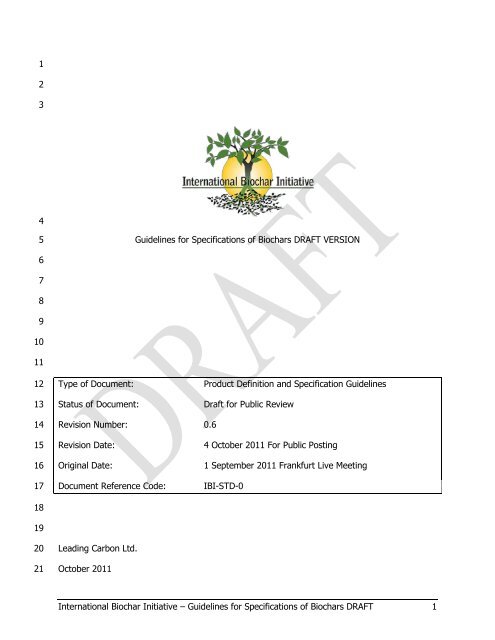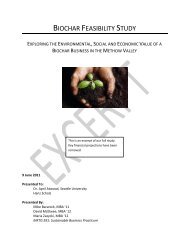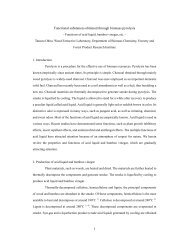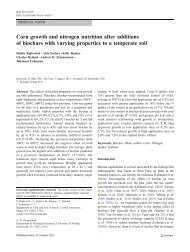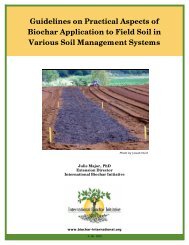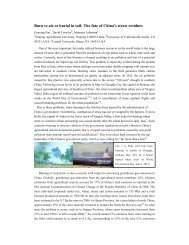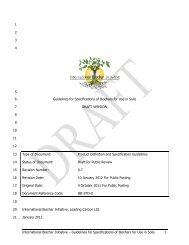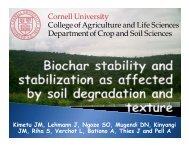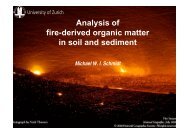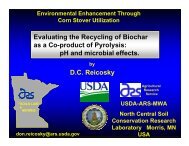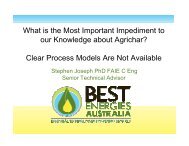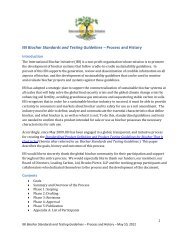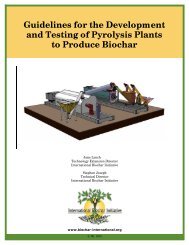Guidelines for Specifications of Biochars - International Biochar ...
Guidelines for Specifications of Biochars - International Biochar ...
Guidelines for Specifications of Biochars - International Biochar ...
You also want an ePaper? Increase the reach of your titles
YUMPU automatically turns print PDFs into web optimized ePapers that Google loves.
12345<strong>Guidelines</strong> <strong>for</strong> <strong>Specifications</strong> <strong>of</strong> <strong><strong>Biochar</strong>s</strong> DRAFT VERSION678910111213Type <strong>of</strong> Document:Status <strong>of</strong> Document:Product Definition and Specification <strong>Guidelines</strong>Draft <strong>for</strong> Public Review14Revision Number: 0.615161718192021Revision Date:Original Date:Document Reference Code:Leading Carbon Ltd.October 20114 October 2011 For Public Posting1 September 2011 Frankfurt Live MeetingIBI-STD-0<strong>International</strong> <strong>Biochar</strong> Initiative – <strong>Guidelines</strong> <strong>for</strong> <strong>Specifications</strong> <strong>of</strong> <strong><strong>Biochar</strong>s</strong> DRAFT 1
1234567891011121314151617DisclaimerThe <strong>International</strong> <strong>Biochar</strong> Initiative (IBI) <strong>Guidelines</strong> <strong>for</strong> <strong>Specifications</strong> <strong>of</strong> <strong><strong>Biochar</strong>s</strong> have beenprepared with the intent <strong>of</strong> providing the public with guidelines to categorize biochars accordingto relevant, reliable and measurable characteristics. In no way shall the IBI or its associates beresponsible <strong>for</strong> the use or misuse <strong>of</strong> in<strong>for</strong>mation and guidance provided in this document. Thisdocument prescribes tests and thresholds only to identify certain qualities and characteristics <strong>of</strong>biochars. No portion <strong>of</strong> this document is intended <strong>for</strong> use as a sustainability or productionprocess guideline. Further documentation and guidance is necessary to identify appropriatesustainability practices and/or safe and effective production processes.The benefits <strong>of</strong> a given biochar product can vary widely with the combination <strong>of</strong> crop, soil andclimate factors. This guidance document makes no claims regarding the potential benefits <strong>of</strong>any given biochar in any particular application. Caution and careful investigation is warrantedwhen selecting biochar <strong>for</strong> an application.The IBI <strong>Guidelines</strong> <strong>for</strong> <strong>Specifications</strong> <strong>of</strong> <strong><strong>Biochar</strong>s</strong> is intended to be a living document. Thisdocument is subject to continuous updates and modifications as the science and body <strong>of</strong>knowledge surrounding biochar continues to evolve. Please ensure that you are using the mostup-to-date version.181920212223242526272829303132333435ForewordThe <strong>Guidelines</strong> <strong>for</strong> <strong>Specifications</strong> <strong>of</strong> <strong><strong>Biochar</strong>s</strong> have been developed by the <strong>International</strong> <strong>Biochar</strong>Initiative (IBI) in collaboration with a wide variety <strong>of</strong> industry and academic experts andthrough public input on an international level. The document was created to encourage furtherdevelopment <strong>of</strong> the biochar industry by providing standardized in<strong>for</strong>mation regarding thecharacterization <strong>of</strong> biochar to assist in achieving more consistent levels <strong>of</strong> product quality. Inaddition to providing product definition and quality specification guidelines, this document hasbeen developed to ensure that consumers have more consistent access to better in<strong>for</strong>mationregarding the quality and physicochemical properties <strong>of</strong> biochar.The <strong>Guidelines</strong> <strong>for</strong> <strong>Specifications</strong> <strong>of</strong> <strong><strong>Biochar</strong>s</strong> are designed to support an IBI certificationprogram. Such a certification program has yet to be developed, but the implementation <strong>of</strong> acertification program will be in<strong>for</strong>med by this document. Separately, the guidelines are alsointended <strong>for</strong> use by various national and regional product standards bodies, national andregional biochar groups <strong>for</strong> their own local adaptation and use, and as a reference in regulatorysituations, as may be appropriate.IBI initiated the guideline creation as a transparent process open to public input. Documentcreation was focused among experts in the field, ensuring an efficient path from concept to finalproduct, and addressing the needs <strong>of</strong> a broad range <strong>of</strong> biochar producers and users. As the<strong>International</strong> <strong>Biochar</strong> Initiative – <strong>Guidelines</strong> <strong>for</strong> <strong>Specifications</strong> <strong>of</strong> <strong><strong>Biochar</strong>s</strong> DRAFT 2
12345678document was developed, public input from the larger international biochar community was alsosought to provide a wider perspective on the use and functionality <strong>of</strong> this tool.The design <strong>of</strong> the <strong>Guidelines</strong> <strong>for</strong> <strong>Specifications</strong> <strong>of</strong> <strong><strong>Biochar</strong>s</strong> follows current best practices andavailable science. As biochar science continues to improve, the document will be updated in aniterative process in order to remain current. There<strong>for</strong>e these guidelines and this document willbe periodically revised through further consultation with the international biochar community.The <strong>Guidelines</strong> <strong>for</strong> the Specification <strong>of</strong> <strong><strong>Biochar</strong>s</strong> document development process is based on thefollowing guiding principles:91011121314151617Maintain congruence with best practice guidance <strong>for</strong> standards development (such asISO, ASTM, IEEE);Strictly adhere to process, ensuring efficient and effective collaboration;Engage the knowledgeable and diverse stakeholder group active in the biochar industry;Organize an independent review committee with broad stakeholder representation,(including project developers, environmental non-governmental organizations (ENGOs),researchers, and so on); and,Rely on existing infrastructure and capacity within IBI <strong>for</strong> leadership and administration<strong>of</strong> the initiative.18192021222324The experts charged with the development <strong>of</strong> the <strong>Guidelines</strong> <strong>for</strong> <strong>Specifications</strong> <strong>of</strong> <strong><strong>Biochar</strong>s</strong> tookpart in two phases <strong>of</strong> working group activities. At the end <strong>of</strong> each phase, new draft documentswere posted, and comments were solicited. Throughout the process, public comments wereincorporated in subsequent revisions <strong>of</strong> the draft. These consisted <strong>of</strong> Phase I, an initial review<strong>of</strong> document <strong>for</strong>matting and characterization criteria, and phase II, an in-depth discussion <strong>of</strong>characterization criteria and reporting levels selection. The working groups <strong>for</strong> each phase wereorganized as follows:25262728Phase 1: Initial review <strong>of</strong> document <strong>for</strong>matting and characterization criteria (December 2010 –March 2011)Working Group #1: North America/South America/Africa29303132333435Jim Amonette, United StatesJason Aramburu, United StatesLouis de Lange, South AfricaMariam Ekebafe, NigeriaJohannes Lehmann, United StatesKim Magrini, United StatesHugh McLaughlin, Canada<strong>International</strong> <strong>Biochar</strong> Initiative – <strong>Guidelines</strong> <strong>for</strong> <strong>Specifications</strong> <strong>of</strong> <strong><strong>Biochar</strong>s</strong> DRAFT 3
123456789 René Pigeon, Canada Joseph Pignatello, United States Miguel Rodriguez, Brazil Rogerio Traballi, Brazil Sunguo Wang, CanadaWorking Group #2: Asia/Europe/ Australia/New Zealand1011121314151617181920212223Marta Camps, New ZealandThomas Harttung, DenmarkMichael Hayes, IrelandStephen Joseph, AustraliaRupam Kataki, IndiaGuitong Li, ChinaFranco Miglietta, ItalyAmran Salleh, MalaysiaYoshiyuki Shinogi, JapanBalwant Singh, AustraliaSaran Sohi, United KingdomLukas Van Zwieten, Australia2425Phase 2: Live, in-depth review <strong>of</strong> characterization criteria and reporting levels selection (July2011)262728293031323334Marta Camps, New ZealandStephen Joseph, AustraliaJohannes Lehmann, United StatesCordner Peacocke, United KingdomMichael Sesko, United StatesSaran Sohi, United KingdomEdward Someus, Sweden<strong>International</strong> <strong>Biochar</strong> Initiative – <strong>Guidelines</strong> <strong>for</strong> <strong>Specifications</strong> <strong>of</strong> <strong><strong>Biochar</strong>s</strong> DRAFT 4
1234567891011121314151617181920212223242526Table <strong>of</strong> ContentsDisclaimer 2Foreword 2Table <strong>of</strong> Contents 51 Scope 62 Effective Date 63 Terms and Definitions 74 Biomass Feedstock Material and <strong>Biochar</strong> Production 94.1 General Feedstock Material Requirements 94.2 General <strong>Biochar</strong> Process and Material Recommendations 95 <strong>Biochar</strong> Product Testing Categories 105.1 Level 1, Entry Level Testing and Declaration - Utility 125.2 Level 2, Moderate Testing and Declaration - Basic Analysis and EnhancementProperties 135.3 Level 3, Advanced Testing and Declaration – Advanced Analysis and EnhancementProperties 156 Product Labeling and Instructions 166.1 Labeling General Requirements 166.2 Product In<strong>for</strong>mation Requirements 166.3 Special instruction 167 Con<strong>for</strong>mity and Record Keeping 177.1 Adequate Sample Testing 177.2 Chain <strong>of</strong> Custody 178 References 18Appendix 1 – Labeling Example 202728<strong>International</strong> <strong>Biochar</strong> Initiative – <strong>Guidelines</strong> <strong>for</strong> <strong>Specifications</strong> <strong>of</strong> <strong><strong>Biochar</strong>s</strong> DRAFT 5
1234567891011121314151617181920212223242526272829301 ScopeIssued by the <strong>International</strong> <strong>Biochar</strong> Initiative (IBI) and based on international consultation, thisdocument is intended to establish testing, measurement, reporting methods, and labelingguidelines <strong>for</strong> the physical and chemical properties <strong>of</strong> biochar. <strong>Biochar</strong> is a solid materialobtained from the carbonization <strong>of</strong> biomass. <strong>Biochar</strong> can be used as a product or an ingredientwithin a blended product, with a range <strong>of</strong> applications as an agent <strong>for</strong> soil improvement,improved resource use efficiency, remediation and/or protection against particularenvironmental pollution, and as an avenue <strong>for</strong> greenhouse gas abatement.These guidelines provide a standardized definition <strong>of</strong> biochar and biochar characteristics relatedto the use <strong>of</strong> biochar as a soil amendment. They will serve as the basis <strong>for</strong> IBI certificationprograms, and are intended <strong>for</strong> use and adaptation to local conditions and regulations by anynation or region. These guidelines support not only baseline safety considerations but also theevolving understanding <strong>of</strong> the positive functions <strong>of</strong> biochar in soil. This document does notprescribe appropriate uses <strong>for</strong> biochar products, nor provide guidelines on what biochar can orshould be used <strong>for</strong>.These guidelines <strong>for</strong> the specifications <strong>of</strong> biochar relate to the physical properties <strong>of</strong> biocharonly, and do not prescribe production methods or feedstock types, nor do they provide limits orterms <strong>for</strong> defining the sustainability and/or greenhouse gas abatement potential <strong>of</strong> a biocharproduct, <strong>for</strong> a certification scheme or otherwise. Although the biochar production and useparameters, listed above, are critical attributes <strong>of</strong> biochar production and application, they willbe addressed in further IBI documents, yet to be developed.Different feedstocks, and hence differentiated testing requirements <strong>of</strong> biochar, are defined inthis guidance document as means <strong>for</strong> the identification and classification <strong>of</strong> a range <strong>of</strong> biochars.This testing scheme is based upon increasing levels <strong>of</strong> physical and chemical property reportingand not necessarily on increasing levels <strong>of</strong> biochar per<strong>for</strong>mance.The intended audiences <strong>for</strong> these guidelines <strong>for</strong> biochar specification include producers, users,regulators, researchers and marketers <strong>of</strong> biochar, as well as the many national and regionalbiochar affiliates <strong>of</strong> the IBI. However, the biochar producer is the entity most likely to apply theguidelines, as a label (<strong>of</strong> differentiation) to the output <strong>of</strong> their production process.3132332 Effective DateThe effective date <strong>of</strong> the <strong>Guidelines</strong> <strong>for</strong> <strong>Specifications</strong> <strong>of</strong> <strong><strong>Biochar</strong>s</strong> is [January 1, 2012]. Thepublic posting and comment period is scheduled <strong>for</strong> autumn 2011.34<strong>International</strong> <strong>Biochar</strong> Initiative – <strong>Guidelines</strong> <strong>for</strong> <strong>Specifications</strong> <strong>of</strong> <strong><strong>Biochar</strong>s</strong> DRAFT 6
12345678910111213141516171819202122232425262728293031323334353 Terms and DefinitionsAsh: The solid mineral fraction <strong>of</strong> biomass or organic material that is not combustible. Ash mayremain as a fixed solid after combustion <strong>of</strong> an organic substance, or it may be entrained as solidparticulate matter in the exhaust gases from combustion.<strong>Biochar</strong>: A solid material obtained from the carbonization <strong>of</strong> biomass.<strong>Biochar</strong> Characteristics: For the purposes <strong>of</strong> these guidelines, biochar characteristics are thosebiochar physical properties that affect the following uses <strong>for</strong> biochar: 1) biochar that is added tosoils with the intention to improve soil functions; and 2) biochar that is produced in order toreduce emissions from biomass (that would otherwise naturally degrade to greenhouse gases)by converting a portion <strong>of</strong> that biomass into a stable carbon fraction that has carbonsequestration value.Biomass: The biodegradable fraction <strong>of</strong> products, waste and residues <strong>of</strong> biological origin fromagriculture (including vegetal and animal substances), <strong>for</strong>estry, and related industries includingfisheries and aquaculture, as well as the biodegradable fraction <strong>of</strong> industrial and municipalwaste (including municipal solid waste). (European Commission Agriculture and RuralDevelopment 2010)Carbonization: The process <strong>of</strong> converting feedstock into biochar through reductive thermalprocessing. The process involves a combination <strong>of</strong> time, heat and pressure exposure factorsthat can vary between processors, equipment and feedstocks.Contaminant: An undesirable material in a biochar or biochar feedstock that compromises thequality or usefulness <strong>of</strong> the biochar. Contaminants include fossil fuels and fossil-fuel-derivedchemical compounds, glass, and metal objects.Diluent/Dilutant: Inorganic material that is deliberately or inadvertently comingled with biomassfeedstock prior to processing. These materials will not carbonize in an equivalent fashion to thebiomass. These materials include common constituents <strong>of</strong> natural soils, such as clays andgravel that may be gathered with biomass or intermixed through prior use <strong>of</strong> the feedstockbiomass. Diluents/dilutants may be found in a diverse range <strong>of</strong> feedstocks, such as agriculturalresidues and municipal solid wastes.Feedstock: The material undergoing the carbonization process to create biochar. Typically,feedstock material <strong>for</strong> biochar consists <strong>of</strong> organic material, but may also contain diluents.Hazardous Materials or Wastes: Potential environmental pollutants that, when concentrated,can be a source <strong>of</strong> regulatory concern <strong>for</strong> any use or application that may influence human orenvironmental health and wellbeing (adapted from US Composting Council and US Department<strong>of</strong> Agriculture 2001).<strong>International</strong> <strong>Biochar</strong> Initiative – <strong>Guidelines</strong> <strong>for</strong> <strong>Specifications</strong> <strong>of</strong> <strong><strong>Biochar</strong>s</strong> DRAFT 7
1234567891011121314151617181920212223242526272829303132333435363738Manufacturer/Producer: The party or parties who process the feedstock materials into biochar,acquire appropriate labeling, and test the biochar properties.Municipal Waste/ Municipal Solid Waste (MSW): Domestic or small commercial non-hazardouswastes. MSW includes food wastes, yard wastes, containers and product packaging, and othermiscellaneous inorganic wastes from residential, commercial, institutional and industrialsources. MSW may contain biodegradable components, recyclable material, inert waste,composite wastes, domestic hazardous waste and sludge. Other discarded material, includingsolid, semi-solid, liquid, or contained gaseous material resulting from community activities canalso be found in MSW. MSW containing hazardous materials or wastes may not be included aseligible feedstocks under these guidelines. It is the manufacturer’s responsibility to ensure thatbiochar feedstock materials are free <strong>of</strong> hazardous materials.Organic Carbon: Biologically degradable carbon-containing compounds found in the organicfraction <strong>of</strong> biochar feedstocks. <strong>Biochar</strong> feedstock can contain such compounds as sugars,starches, proteins, fats, cellulose and lignocellulose, which are degradable by reductive thermalprocessing. Other organic carbon <strong>for</strong>ms can include petroleum and petroleum byproducts suchas plastics and contaminated oils, which are, <strong>for</strong> the purposes <strong>of</strong> this document, included withinthe definition <strong>of</strong> contaminants, but may also be thermally degraded. The organic carbonfraction does not include inorganic carbonate concretions such as calcium and magnesiumcarbonates. (adapted from US Composting Council and US Department <strong>of</strong> Agriculture 2001)Organic Material: Biological material derived from, or produced by living or recently livingorganisms. This material can be ”unprocessed” or ”processed”. Unprocessed material is livingmaterial, or recently living material, (biomass) that may have been mechanically resized (suchas wood chips), but has not gone through an anthropogenic chemical modification. Processedmaterial is recently living material that has been chemically modified by anthropogenic orbiological processes (e.g., paper sludge, manure). This document recognizes that otherdefinitions <strong>of</strong> “organic” exist such as those <strong>of</strong> organic chemistry;; however, <strong>for</strong> the purposes <strong>of</strong>these guidelines the IBI has opted to define “organic” within these narrower bounds.Processed Feedstock: Biomass that has gone through chemical processing (<strong>for</strong> example,chemical treatment such as occurs with wood preservatives and paper pulp sludges) orbiological processing (<strong>for</strong> example, digestion, such as manures and sludge from waste effluenttreatment) beyond simple mechanical processing to modify physical properties.Residence Time: The time a feedstock is held within a consistent temperature range in a givencarbonization process.Soil Functions: Soil functions are defined by the proposal <strong>for</strong> a European Soil FrameworkDirective COM(2006)232, as follows: “(i) biomass production, including in agriculture and<strong>for</strong>estry; (ii) storing, filtering and trans<strong>for</strong>ming nutrients, substances and water; (iii) hosting thebiodiversity pool, such as habitats, species and genes; (iv) acting as a plat<strong>for</strong>m <strong>for</strong> humanactivities; (v) source <strong>of</strong> raw materials; (vi) acting as carbon pool; and (vii) storing geological<strong>International</strong> <strong>Biochar</strong> Initiative – <strong>Guidelines</strong> <strong>for</strong> <strong>Specifications</strong> <strong>of</strong> <strong><strong>Biochar</strong>s</strong> DRAFT 8
123456and archeological heritage.” The guidelines and this document will focus on functions <strong>of</strong> biocharin soils.Unprocessed Feedstock: Biomass that has not gone through chemical processing (that is,chemical treatment, such as wood preservatives and sludges) or biological processing (that is,digestion, such as manures and sludges) processing, but may have gone through mechanicalprocessing to change its physical properties, including particle size.78910111213141516171819202122232425262728294 Biomass Feedstock Material and <strong>Biochar</strong> Production4.1 General Feedstock Material RequirementsThe materials used as feedstocks <strong>for</strong> biochar production have direct impacts on the nature andquality <strong>of</strong> the resulting biochar. Although the focus <strong>of</strong> this document is on the resulting biochar,some restrictions have been applied to feedstock contents and quality. To qualify as biocharunder these guidelines, the feedstock may be any combination <strong>of</strong> biomass and diluents, andmay not contain more than 2% by dry weight <strong>of</strong> contaminants, (following Brinton 2000).Suitable feedstocks include but are not limited to agriculture, food, and <strong>for</strong>estry residues, whichmay contain a minimal quantity <strong>of</strong> contaminants as part <strong>of</strong> the feedstock.Note: Issues <strong>of</strong> feedstock sustainability are to be addressed in other IBI or related documentsnot included herein.4.2 General <strong>Biochar</strong> Process and Material RecommendationsThis guidance does not prescribe production and handling expectations <strong>for</strong> biochar, but insteadprovides recommendations <strong>for</strong> safe production processes. It is the responsibility <strong>of</strong> the biocharmanufacturer to create biochar in a safe manner. The IBI recommends that best industrypractices be followed throughout the manufacturing process.Local requirements and regulations <strong>for</strong> the operation <strong>of</strong> biochar production facilities should befollowed. Where applicable, biochar production must comply with local and internationalregulatory requirements and treaties that govern thermal processes, the production <strong>of</strong> volatileand particulate emissions, and the transport <strong>of</strong> goods. Relevant to local and internationalregulatory compliance, biochar producers should follow the two recommendations listed below:3031323334A biochar producer should provide a relevant material safety data sheet (MSDS) <strong>for</strong> thefinal output <strong>of</strong> its particular biochar production process. Brief outlines <strong>of</strong> MSDSdocument creation are available from numerous online sources, including MSDS Search,the Canadian Center <strong>for</strong> Occupational Health and Safety, and the US Department <strong>of</strong>Labor Occupational Health and Safety Administration.<strong>International</strong> <strong>Biochar</strong> Initiative – <strong>Guidelines</strong> <strong>for</strong> <strong>Specifications</strong> <strong>of</strong> <strong><strong>Biochar</strong>s</strong> DRAFT 9
123<strong>Biochar</strong> should be tested to address the potential <strong>for</strong> self-heating and flammabilityduring storage and transportation. Documentation <strong>of</strong> the results <strong>of</strong> this testing shouldbe appended to the MSDS.45678While the IBI may not require these practices as part <strong>of</strong> its definition and certification <strong>of</strong> biocharsince they do not relate directly to product quality, they are important considerations in goodbusiness practice and responsible industrial production. The majority <strong>of</strong> nations providedetailed guidelines, expectations and regulations governing the manufacturing sector and willhave relevant in<strong>for</strong>mation available to industrial operators.910111213145 <strong>Biochar</strong> Product Testing CategoriesAs is described in this section, biochar products shall be categorized based on the extent <strong>of</strong>testing and content analysis (relative to defined thresholds) completed <strong>for</strong> the given biocharmaterial. The categorization structure is designed to:15161718192021Provide a uni<strong>for</strong>m presentation <strong>for</strong>mat by which a biochar user would be able to fairlycompare and assess the reported properties <strong>of</strong> different biochars to determine if aparticular biochar is suitable <strong>for</strong> a specific application.Incrementally increase the requirements <strong>of</strong> physical and chemical data reporting, so thata higher level <strong>of</strong> characterization and testing provides a more comprehensiveunderstanding <strong>of</strong> the composition and properties <strong>of</strong> the material, as well as a betterunderstanding <strong>of</strong> “fit <strong>for</strong> purpose”.22232425262728293031Each testing level category was developed according to an assessment <strong>of</strong> the relevantparameters <strong>for</strong> biochar qualities, characteristics, and safety, balanced against cost andaccessibility. This document, however, does not provide guidance on the interpretation <strong>of</strong> theseparameters relative to the beneficial uses and applications <strong>of</strong> biochar. Rather, the intent <strong>of</strong> thiscategorization structure is to provide increasing detail on the relevant parameters <strong>of</strong> the biocharin order to support decision-making by users, according to their own requirements.This guidance document defines three levels <strong>for</strong> testing <strong>of</strong> biochar, which are as follows:Level 1 - Entry Level: <strong>Biochar</strong> meets entry level requirements if it has been tested <strong>for</strong>the most basic parameters required to assess utility. Level 1 applies only to biocharfrom unprocessed feedstock. 11 The exclusion <strong>of</strong> processed feedstocks from qualifying as Level 1 biochar reflects the need <strong>for</strong> furtheranalysis to provide suitable assurance <strong>of</strong> the composition and properties <strong>of</strong> biochar made from processedfeedstocks.<strong>International</strong> <strong>Biochar</strong> Initiative – <strong>Guidelines</strong> <strong>for</strong> <strong>Specifications</strong> <strong>of</strong> <strong><strong>Biochar</strong>s</strong> DRAFT 10
12345678910Level 2 - Moderate Level: <strong>Biochar</strong> that meets moderate level requirements has beentested <strong>for</strong> basic analysis and enhancement properties and meets some toxicitythresholds, in addition to the requirements <strong>of</strong> Level 1, regardless <strong>of</strong> whether it is <strong>of</strong>unprocessed or processed feedstock origin.Level 3 - Advanced Level: <strong>Biochar</strong> that has been tested <strong>for</strong> advanced analysis andenhancement properties and meets some additional toxicity thresholds, in addition tomeeting the requirements <strong>of</strong> Level 2.Further details on each <strong>of</strong> the testing categories are provided in the following subsections. Anillustration <strong>of</strong> the interrelationship between the testing level categories is provided in Figure 1,below.1112131415Level 1Entry LevelLevel 2ModerateFigure 1: Flow Chart <strong>of</strong> <strong>Biochar</strong> Testing and Declaration LevelsLevel 3Advanced<strong>International</strong> <strong>Biochar</strong> Initiative – <strong>Guidelines</strong> <strong>for</strong> <strong>Specifications</strong> <strong>of</strong> <strong><strong>Biochar</strong>s</strong> DRAFT 11
1234567891011125.1 Level 1, Entry Level Testing and Declaration - Utility<strong>Biochar</strong> that is characterised exclusively under Level 1 category tests must originate fromunprocessed feedstocks. <strong>Biochar</strong> from processed feedstocks must be characterized by Level 2or higher category tests.Producers <strong>of</strong> biochar that has been tested to Level 1 must declare all basic biocharcharacteristics outlined below, meet carbon content ratio minimums, and pass vegetative andinvertebrate vigour tests to meet the requirements <strong>of</strong> a Level 1 testing category. Basic biocharcharacteristics include the physical properties <strong>of</strong> particle size and moisture content, as well aschemical properties <strong>of</strong> element proportions (H, C and N), ash proportion and pH/liming ability.<strong><strong>Biochar</strong>s</strong> tested to Level 1 shall con<strong>for</strong>m to all requirements presented in Table 1 below:Table 1: Level 1 Characteristics and CriteriaRequirement Criteria Unit Test Method13Basic <strong>Biochar</strong> CharacterizationMoisture ContentTotal AshOrganic CarbonInorganic CarbonH:C orgTotal NpHLiming(if pH is above 7)Particle sizedistributionDeclaration50%(Maximum)DeclarationDeclaration0.7(Maximum)DeclarationDeclaration% <strong>of</strong> totalmass% <strong>of</strong> totalmass% <strong>of</strong> totalmass% <strong>of</strong> totalmassMolar ratio% <strong>of</strong> totalmassASTM D1762-84 (specify measurement date withrespect to time from production)Apply loss on ignition (ASTM D1762-84) to ascertaintotal non-carbonate ash, then add back inorganiccarbon as carbonate.C, H, N analysis by dry combustion (Dumas method),be<strong>for</strong>e (total C) and after (organic C) HCl addition;inorganic C is the difference between total and organicC.Dry combustion (Dumas method) and gaschromatography, following same procedure as <strong>for</strong> C, H,N analysis above, without HCl addition.Activated carbon pH, as outlined inAhmedna et al. (2000), and Ahmedna et al (1997)Declaration % CaCO3 Rayment & Higginson (1992)DeclarationVegetative and Invertebrate VigourEarthwormAvoidance TestPass/FailGerminationInhibition AssayPass/Fail% or totalmass ineach classProgressive dry sieving with 200μm, 2,000μm and20,000μm sieves, as outlined inASTM D5158-98 - Method <strong>for</strong> activated carbonOECD methodology (1984) as described by VanZwieten et al. (2009)OECD methodology (2004) 3 test species, as describedby Van Zwieten et al. (2009)<strong>International</strong> <strong>Biochar</strong> Initiative – <strong>Guidelines</strong> <strong>for</strong> <strong>Specifications</strong> <strong>of</strong> <strong><strong>Biochar</strong>s</strong> DRAFT 12
123456789101112135.2 Level 2, Moderate Testing and Declaration - Basic Analysis andEnhancement Properties<strong><strong>Biochar</strong>s</strong> tested to Level 2 must meet basic soil toxicity assessment guidelines and thresholds asoutlined in Table 2 below, report basic soil enhancement properties, and meet all Level 1requirements to meet the requirements <strong>of</strong> a Level 2 testing category, regardless <strong>of</strong> whether thebiochar is derived from a processed or unprocessed feedstock. Basic soil enhancementproperties include N, P and K nutrient content, and electrical conductivity, while basic soiltoxicity assessment guidelines follow commonly-identified soil toxicity and soil amendmentchemical content reporting requirements (soil amendments include fertilizers and composts).All values must be reported in order to meet test Level 2 categorization. Where values exceedthreshold levels, as outlined in Table 2, biochars will not achieve a Level 2 ranking.<strong><strong>Biochar</strong>s</strong> tested to Level 2 shall con<strong>for</strong>m to all requirements presented in Table 2 below:Table 2: Level 2 Characteristics and CriteriaRequirement Criteria Unit Criteria/Test MethodBasic Soil ToxicityMaximum AllowedThresholdArsenic 13 mg/kg Bureau de normalisation du Québec (2005)Cadmium 1.4 mg/kg Amlinger, Faroino and Pollack, (2004)Chromium 93 mg/kg Amlinger, Faroino and Pollack, (2004)Cobalt 34 mg/kg Bureau de normalisation du Québec (2005)Copper 143 mg/kg Amlinger, Faroino and Pollack, (2004)Lead 121 mg/kg Amlinger, Faroino and Pollack, (2004)Molybdenum 5 mg/kg Bureau de normalisation du Québec (2005)Mercury 1.0 mg/kg Amlinger, Faroino and Pollack, (2004)Nickel 47 mg/kg Amlinger, Faroino and Pollack, (2004)Selenium 2 mg/kg Bureau de normalisation du Québec (2005)Zinc 416 mg/kg Amlinger, Faroino and Pollack, (2004)BoronUS Composting Council and US Department <strong>of</strong>Declaration mg/kgAgriculture (2001)ChlorineUS Composting Council and US Department <strong>of</strong>Declaration mg/kgAgriculture (2001)SodiumUS Composting Council and US Department <strong>of</strong>Declaration mg/kgAgriculture (2001)Basic Soil Enhancement PropertiesTotal P & K 2% Modified dry ashing followed by ICP (Enders andDeclarationcontent Lehmann 2011)Mineral N(ammonium andnitrate)Declarationmg/kg2M KCl extraction, followed by spectrophotometry(Rayment and Higginson 1992)Available P Declaration mg/kg 2% <strong>for</strong>mic acid followed by spectrophotometry2 Total K is sufficiently equivalent to available K <strong>for</strong> the purpose <strong>of</strong> this categorization<strong>International</strong> <strong>Biochar</strong> Initiative – <strong>Guidelines</strong> <strong>for</strong> <strong>Specifications</strong> <strong>of</strong> <strong><strong>Biochar</strong>s</strong> DRAFT 13
Requirement Criteria Unit Criteria/Test Method1ElectricalConductivityDeclarationS/m(modified from Rajan et al 1992, Nutrient Cycl inAgroecosystems 32:291-302 and AOAC 2005, asused by Wang et al. 2011 Submitted to Plant andSoil)Method 3.A1 Rayment and Higginson 1992; EC <strong>of</strong> 1:5soil/water content<strong>International</strong> <strong>Biochar</strong> Initiative – <strong>Guidelines</strong> <strong>for</strong> <strong>Specifications</strong> <strong>of</strong> <strong><strong>Biochar</strong>s</strong> DRAFT 14
123456789105.3 Level 3, Advanced Testing and Declaration – Advanced Analysis andEnhancement Properties<strong><strong>Biochar</strong>s</strong> tested to Level 3 must meet a series <strong>of</strong> advanced toxicity assessment requirementsand report on a set <strong>of</strong> advanced soil enhancement properties, in addition to meeting all testLevel 1 and test Level 2 requirements, regardless <strong>of</strong> whether the biochar is derived from aprocessed or unprocessed feedstock. Advanced soil toxicity reporting reflects theconcentrations <strong>of</strong> volatile aromatic compounds, while advanced soil enhancement propertiesidentify the porosity and surface area <strong>of</strong> biochars.<strong><strong>Biochar</strong>s</strong> tested to Level 3 shall con<strong>for</strong>m to all requirements presented in Table 3 below:Table 3: Level 3 Characteristics and CriteriaRequirement Criteria Unit Test Method11Advanced Soil Toxicity ReportingMaximum AllowedThresholdPolychorinatedBiphenylsPolycyclic AromaticHydrocarbons (PAH)0.2Furan 0.5Dioxin 0.56mg/kgTM orTEQmg EPAPAH/kgTMng/kg ITEQOMSng/kg ITEQOMSThreshold criteria following Amlinger, Faroino andPollack, (2004). Method following US EnvironmentalProtection Agency (1996)US Environmental Protection Agency (2007)Advanced Soil Enhancement PropertiesPorosity Declaration % ASTM 1510-11a Iodine Adsorption MethodSurface Area Declaration m2/g<strong>International</strong> <strong>Biochar</strong> Initiative – <strong>Guidelines</strong> <strong>for</strong> <strong>Specifications</strong> <strong>of</strong> <strong><strong>Biochar</strong>s</strong> DRAFT 15
1234567891011121314156 Product Labeling and InstructionsProduct labeling and in<strong>for</strong>mation sharing will become an important part <strong>of</strong> any subsequentlydeveloped biochar certification program. In order to qualify <strong>for</strong> certification, biochar producersand manufacturers must share in<strong>for</strong>mation about the feedstock and final biochar product.Communication <strong>of</strong> biochar qualities, test levels, and feedstock origins must be conducted in auni<strong>for</strong>m way to create an easily understood certification program that end-consumers will beable to support.6.1 Labeling General RequirementsTo meet the requirements <strong>of</strong> this guidance document, a label shall be attached, provided in aweb-link, or otherwise included with all transactional documents, packaging, advertisement orother commercial documentation associated with the biochar. This label shall be legible andplaced in a fashion that is visible and clear on the biochar packaging or documentation.6.2 Product In<strong>for</strong>mation RequirementsIncluded with the label, the manufacturer <strong>of</strong> the biochar shall make available to the purchaser,in<strong>for</strong>mation pertaining to:16171819Feedstock material(s) including content (by weight) <strong>of</strong> diluents within the biocharfraction.Country <strong>of</strong> origin <strong>for</strong> biochar feedstock and production.All relevant in<strong>for</strong>mation required by test level categories.2021222324256.3 Special instructionThe manufacturer shall make available to the user instructions <strong>for</strong> suitable use, storage andtransportation <strong>of</strong> the biochar in compliance with Hazardous Materials Identification System(HMIS) requirements, or other occupational health and safety requirements, as required by theprevailing jurisdiction. Specifically, this in<strong>for</strong>mation should include guidance on the safe care,storage and handling <strong>of</strong> the biochar.26<strong>International</strong> <strong>Biochar</strong> Initiative – <strong>Guidelines</strong> <strong>for</strong> <strong>Specifications</strong> <strong>of</strong> <strong><strong>Biochar</strong>s</strong> DRAFT 16
12345678910111213141516171819202122232425267 Con<strong>for</strong>mity and Record KeepingAdequate documentation and reporting are required by producers seeking to gain the IBI’sconfidence, or that <strong>of</strong> any national or regional certification program. The reporting <strong>of</strong> biocharfeedstock contents and end-product quality are both necessary to provide assurance in endproductuni<strong>for</strong>mity. Record keeping will be mandatory, in order to establish pro<strong>of</strong> <strong>of</strong> adequatesampling, analysis, meeting <strong>of</strong> thresholds, and <strong>for</strong> pro<strong>of</strong> <strong>of</strong> product test level categoryqualification over time.7.1 Adequate Sample Testing<strong>Biochar</strong> properties and characteristics according to the specification guidelines shall be assessedand reported as follows (whichever is most frequent):- After every 600 metric tonnes (dry weight) <strong>of</strong> consistent feedstock through-put; or,- Every 6 months; or,- After a material change in feedstock; 3 or,- After a material change in production parameters. 4Assessment, testing and categorization <strong>of</strong> biochar should occur be<strong>for</strong>e final storage or blending<strong>of</strong> product. Sampling <strong>of</strong> biochar shall be conducted by trained and accredited laboratorypr<strong>of</strong>essionals following the appropriate procedures identified <strong>for</strong> each test within a categorylevel. <strong>Biochar</strong> analysis shall follow strict quality control requirements according to standardizedlaboratory procedures. Documentation <strong>of</strong> biochar production and certification reporting andanalyses should be kept <strong>for</strong> seven years.7.2 Chain <strong>of</strong> CustodyChain <strong>of</strong> custody and product traceability will require an assurance that adequate care andtransparency is being exercised to enable trace-back <strong>of</strong> final end-products from end-usersacross the biochar market to manufacturers and feedstock suppliers. All levels in the biocharproduction and supply chain will be required to participate in record keeping, in order tomaintain quality assurance.273 Material changes in feedstock reflect gross shifts in feedstock type from one source <strong>of</strong> biomass to adistinctly different source <strong>of</strong> biomass (e.g. corn stover switched to wood chips).4 Material changes in production processes reflect increases or decreases in process temperature (i.e. +/-50˚C), or mean residence time (i.e. +/- 10 minutes in a continuous process).<strong>International</strong> <strong>Biochar</strong> Initiative – <strong>Guidelines</strong> <strong>for</strong> <strong>Specifications</strong> <strong>of</strong> <strong><strong>Biochar</strong>s</strong> DRAFT 17
12345678910111213141516171819202122232425262728293031323334353637388 ReferencesAhmedna, M., Johns, M.M., Clarke, S.J., Marshall, and W.E., Rao, R.M. (1997) Potential <strong>of</strong>agricultural by-product-based activated carbons <strong>for</strong> use in raw sugar decolourization.Journal <strong>of</strong> the Science <strong>of</strong> Food and Agriculture. 75, 117-124.Ahmedna, M., Marshall, W.E., and Rao, R.M. (2000) Production <strong>of</strong> granular activated carbonsfrom select agricultural by-products and evaluation <strong>of</strong> their physical, chemical andadsorption properties. Bioresource Technology 71: 113-123Amlinger, F., Faroino, E., and Pollack, M. (2004) EU Heavy Metals and Organic Compounds fromWaste Used as Organic Fertilizers Final Report ENV.A.2./ETU/2001/0024 REF.NR.:TEND/AML/2001/07/20AOAC <strong>International</strong> (2005) AOAC Official Methods <strong>of</strong> Analysis. 18 th Edition. Latimer, G. (Ed.)www.eoma.aoac.org (accessed September 2011)ASTM <strong>International</strong> (2009) ASTM D1510 - 11a Standard Test Method <strong>for</strong> Carbon Black—IodineAdsorption Number http://www.astm.org/Standards/D1510.htm (accessed September2011)ASTM <strong>International</strong> (2007) ASTM D1762-84 (2007) Standard Test Method <strong>for</strong> Chemical Analysis<strong>of</strong> Wood Charcoal http://www.astm.org/Standards/D1762.htm (accessed September2011)ASTM <strong>International</strong> (2005) ASTM D5158-98 (2005) Standard Test Method <strong>for</strong> Determination <strong>of</strong>Particle Size <strong>of</strong> Powdered Activated Carbon by Air Jet Sievinghttp://www.astm.org/Standards/D5158.htm (accessed September 2011)Brinton, W.F. (2000) Compost quality standards and guidelines. Woods End ResearchLaboratory, prepared <strong>for</strong> New York State Association <strong>of</strong> Recyclers.http://compost.css.cornell.edu/Brinton.pdf (accessed September 2011)Bureau de normalisation du Québec (2005) National Standard <strong>of</strong> Canada, Organic SoilConditioners – Compost. CAN/BNQ 0413-200 (2005) ISBN: 2-551-22659-7 http://wwwes.criq.qc.ca/pls/owa_es/bnqw_norme.detail_norme?p_lang=en&p_id_norm=8184&p_code_menu=NORME (accessed September 2011)Enders and Lehmann (2011) Communications in Soil Science and Plant Analysis. In Press.European Commission Agriculture and Rural Development (2010) Biomass Potentialhttp://ec.europa.eu/agriculture/bioenergy/potential/index_en.htm (accessed September2011)European Commission COM(2006) Directive Establishing a Framework <strong>for</strong> the Protection <strong>of</strong> Soiland Amending Directive 2004/35/EChttp://ec.europa.eu/environment/soil/pdf/com_2006_0232_en.pdf (accessed September2011)<strong>International</strong> <strong>Biochar</strong> Initiative (2010) IBI <strong>Guidelines</strong> <strong>for</strong> the Development and Testing <strong>of</strong>Pyrolysis Plants to Produce <strong>Biochar</strong> http://www.biochar-<strong>International</strong> <strong>Biochar</strong> Initiative – <strong>Guidelines</strong> <strong>for</strong> <strong>Specifications</strong> <strong>of</strong> <strong><strong>Biochar</strong>s</strong> DRAFT 18
1234567891011121314151617181920212223242526272829international.org/sites/default/files/IBI-Pyrolysis-Plant-<strong>Guidelines</strong>.pdf (accessedSeptember 2011)Rajan, S.S.S., Brown, M.W., Boyes, M.K., and Upsdell, M.P. (1992) Extractable phosphorus topredict agronomic effectiveness <strong>of</strong> ground and unground phosphate rocks. NutrientCycling in Agroecosystems. 32(3): 291-302http://www.springerlink.com/content/j008x0248v237318/ (Accessed September 2011)Rayment, G.E. and Higginson, F.R. (1992). Australian Laboratory Handbook <strong>of</strong> Soil and WaterChemical Methods (Reed <strong>International</strong> Books, Australia/ Inkata Press, Port Melbourne)AndRayment, G.E., and Lyons, D.J. (2011) Soil Chemical Methods – Australasia. CSIRO Publishing,Collingwood, Victoria, Australia.US Composting Council and US Department <strong>of</strong> Agriculture (2001) Test methods <strong>for</strong> theexamination <strong>of</strong> composting and compost. (TMECC) Thompson W.H. (ed.)http://compostingcouncil.org/tmecc/US Environmental Protection Agency (1996) METHOD 8275A Semivolatile organic compounds(PAHs AND PCBs) in soils/sludges and solid wastes using thermal extraction/gaschromatography/mass spectrometry (TE/GC/MS)http://www.epa.gov/osw/hazard/testmethods/sw846/pdfs/8275a.pdf (accessedSeptember 2011)US Environmental Protection Agency (2007) EPA METHOD 8290A Polychlorinated Dibenzo-P-Dioxins (PCDDs) and polychlorinated dibenz<strong>of</strong>urans (PCDFs) by high resolution gaschromatography/high resolution mass spectrometry (HRGC/HRMS)http://www.epa.gov/osw/hazard/testmethods/sw846/pdfs/8290a.pdf (accessedSeptember 2011)VanZwieten, L., Kimber, S., Morris, S., Chan, K.Y., Downie, A., Rust, J., Joseph, S., and Cowie,A. (2009) Effects <strong>of</strong> biochar from slow pyrolysis <strong>of</strong> papermill waste on agronomicper<strong>for</strong>mance and soil fertility. Plant and Soil 327(1-2) 235-246Wang, T., Camps Arbestain, M., Hedley, M., and Bishop, P. (2011) Predicting phosphorusbioavailability from high-ash biochars. Currently under review.30<strong>International</strong> <strong>Biochar</strong> Initiative – <strong>Guidelines</strong> <strong>for</strong> <strong>Specifications</strong> <strong>of</strong> <strong><strong>Biochar</strong>s</strong> DRAFT 19
1234567Appendix 1 – Labeling ExampleThe following is an example <strong>of</strong> adequate product labeling with the necessary productin<strong>for</strong>mation as described in this guidance document:Farmer Joe’s Good-Grow <strong>Biochar</strong>-Compost BlendMATERIAL TYPE <strong>Biochar</strong> Tested to Level 1FEEDSTOCK TYPE WOODY RESIDUES, SAW DUST, BARKBIOCHAR PROPERTIES:Moisture 20%Total Ash 10%Organic Carbon 32%Inorganic Carbon 18%H:C org 0.8pH 6.5Total N 14.4%Particle Size Distribution 20% 20,000 µm 5Germination Assay PassEarthworm Assay PassPACKAGE INGREDIENTS,BY WEIGHT50% - BIOCHAR50% - COMPOSTED SOIL MIXTURECOUNTRY OF ORIGIN USAPlease see attached MSDS documentation <strong>for</strong> appropriate shipping, handlingand storage procedures.These guidelines apply only to biochar, and thus require only the biochar portion <strong>of</strong> a blendedproduct to be reported in the product in<strong>for</strong>mation.8910IBI will provide an updated label including certification date, registration number and IBI logo atthe point <strong>of</strong> achieving certification and upon agreement on the terms <strong>of</strong> use.5 The goal with particle size distribution is to reach the mid-range <strong>of</strong> 200-20,000 micrometers (µm). The20,000µm categories are minimum and maximum standards.<strong>International</strong> <strong>Biochar</strong> Initiative – <strong>Guidelines</strong> <strong>for</strong> <strong>Specifications</strong> <strong>of</strong> <strong><strong>Biochar</strong>s</strong> DRAFT 20


